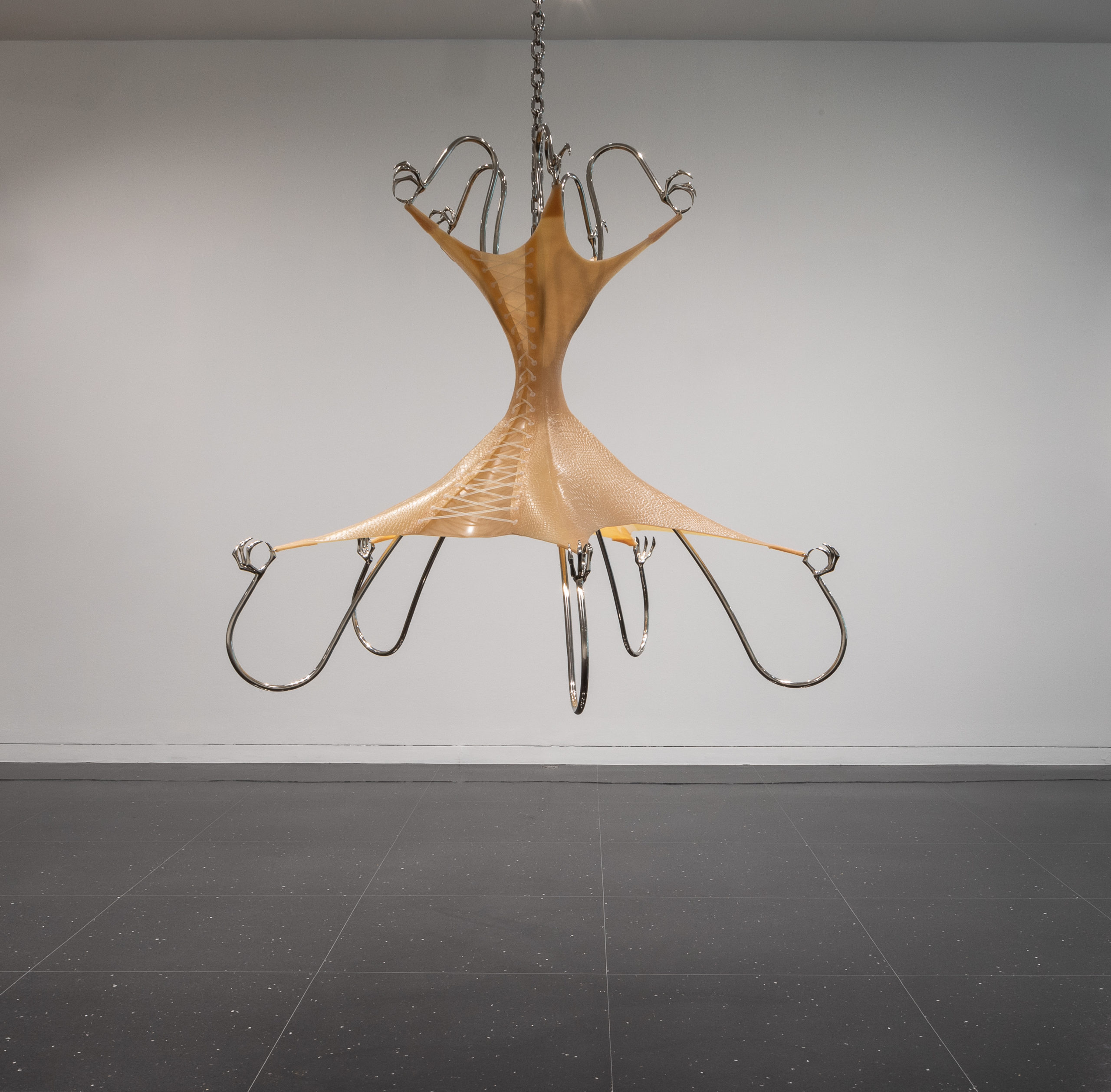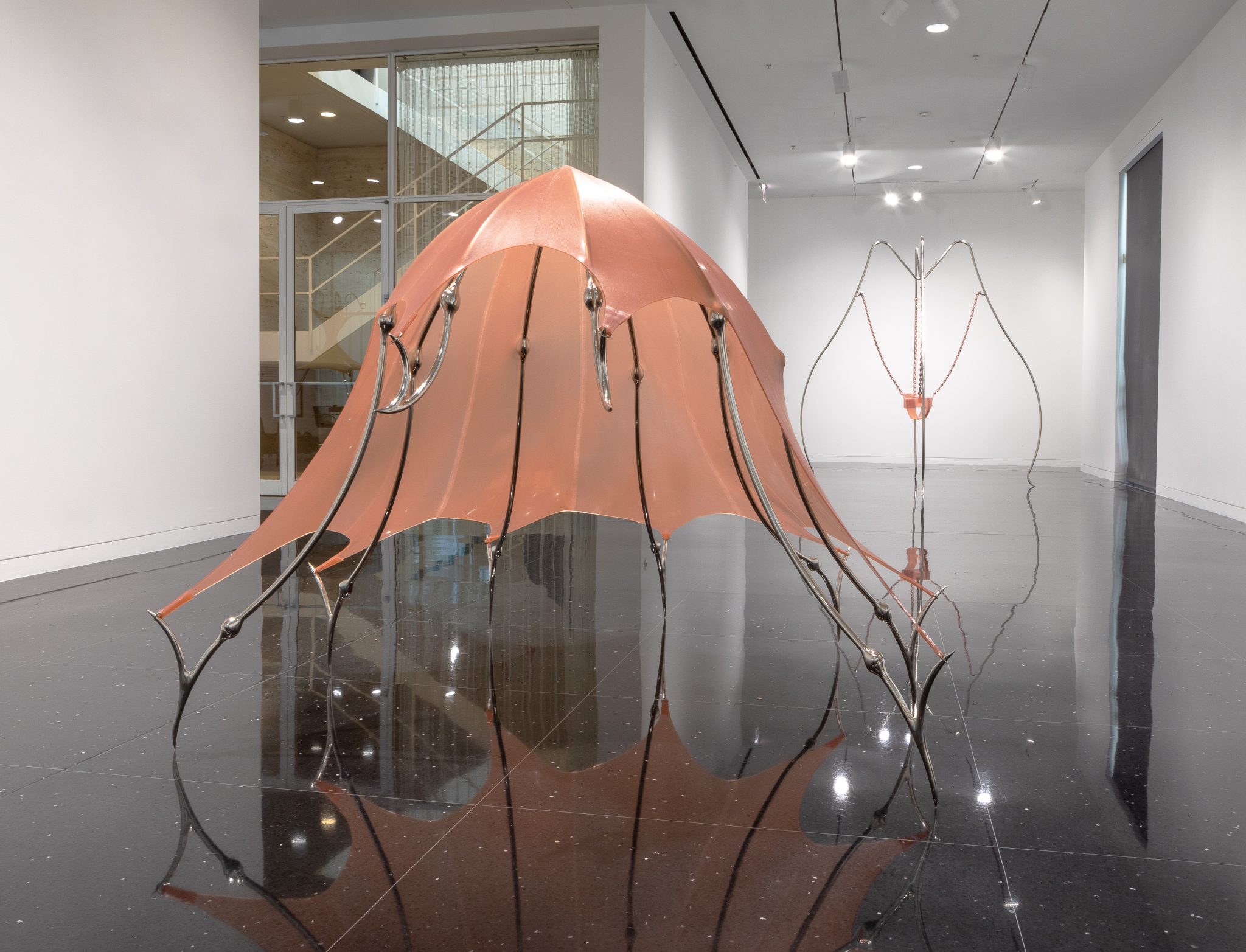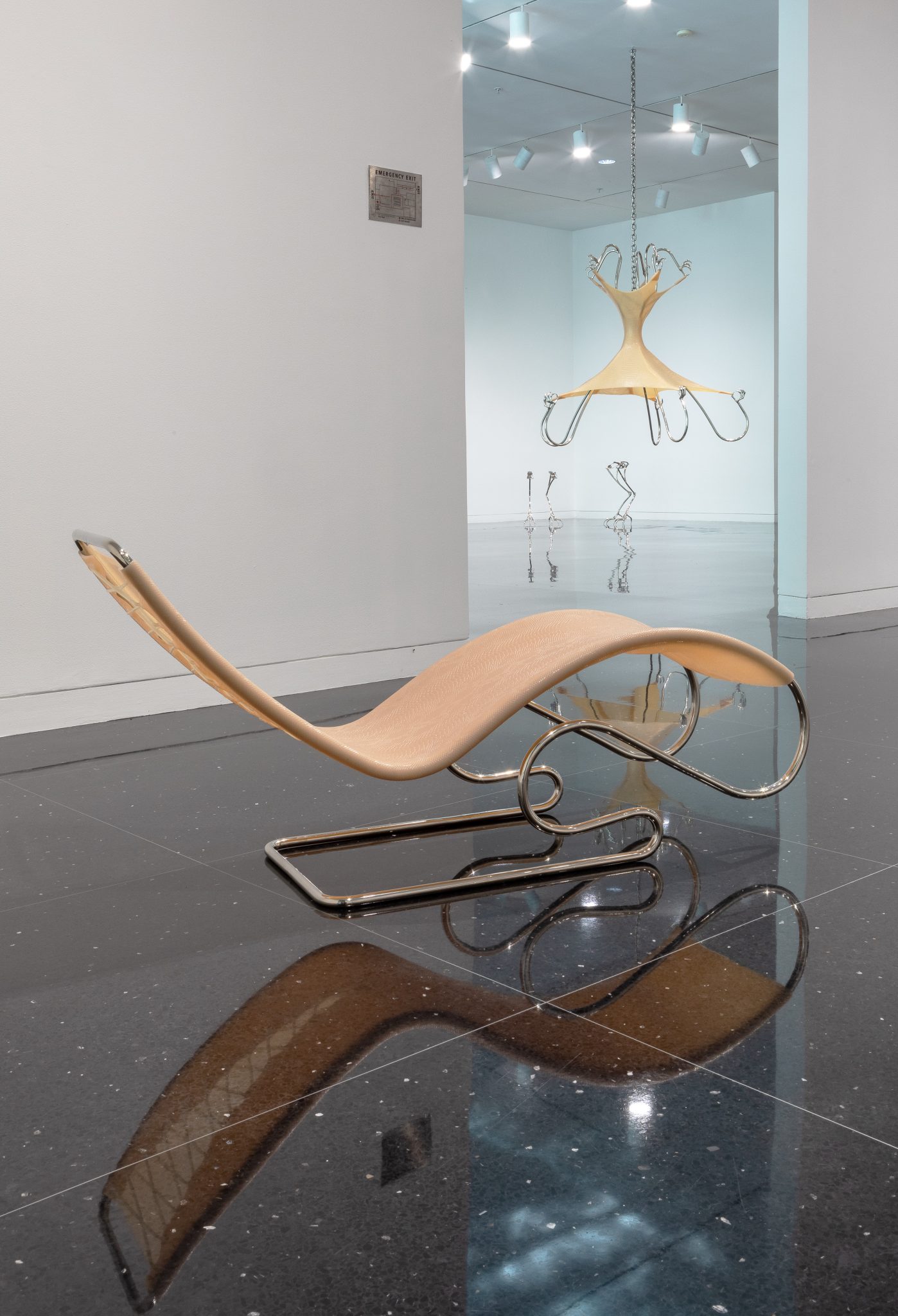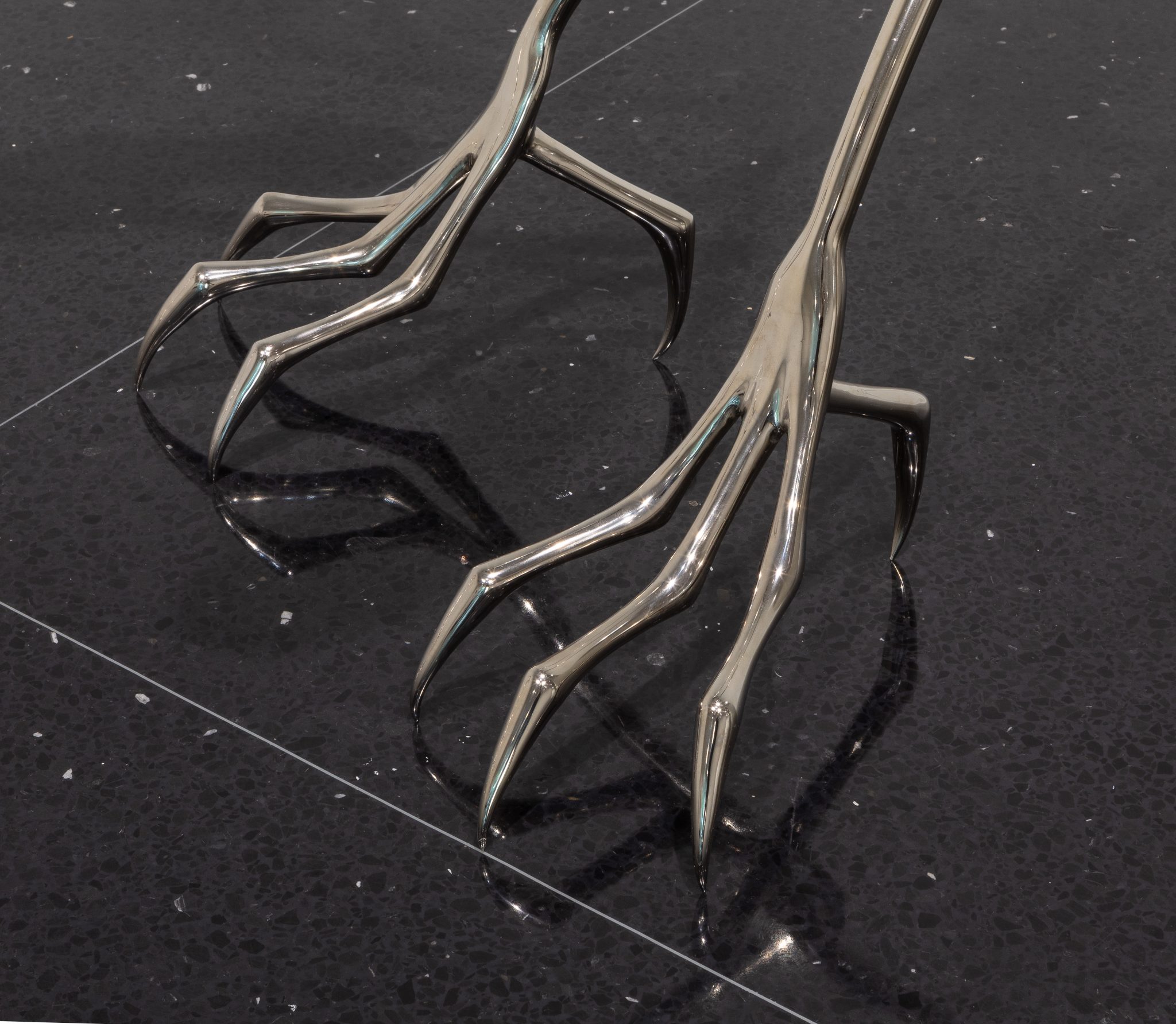

Untitling Pleasures: A conversation with Hannah Levy on tension & sensation
By Hindley Wang, published on Sixty Inches from Center. Jan.15, 2022.
Roland Barthes describes the striptease as a “delicious threat…a spectacle based on fear.”
He conceives that, above all, a striptease is a contradiction: the instant of complete undress marks the frightening desexualization of the entertaining object—the object of sex being, and in this case (as in most cases) the “Woman”.
A double negative.
This is what came to mind when I saw Hannah Levy’s work in her show Surplus Tension at the Arts Club of Chicago. Note that the tease is not spoiled here–yet.
Rather, what is on display captures the edging and agonizing voyage to full disclosure–caught in a contended seesaw with the excess of visual desire on one end, and the obstinate labor of concealment of such desire on the other.
It is a kind of conundrum traced in Barthes’ theory:
the fear oscillating between the objectification of the woman and her desexualization
–though, the two are never mutually exclusive, and the fear in question seems to be a privilege that disconcerns the woman. Instead of teasing out this fantasized fear, Levy’s work vibrates with a different register of anxiety, reverberating in savory silence and seeping with quiet pleasures.
In Levy’s piece Untitled chandelier, the taut, resistant silicon embraces the unfurled claws of the metal chandelier, gesturing a tease in suspension. The tease is suspended in time and space, quite literally, through an articulate gesture of anxiety–between realms of pleasure and repulsion, pressure and release. It configures a very delicate line, drawn as a race against time, infinitely prolonging the supposed operative negation of flesh under a striptease, as Barthes suggests. The lace on the back of the corset remains intact, unconstraining, transparent. The tension is to be located elsewhere.
Instead of playing into the negation, the Untitled chandelier at the entrance of the space proposes a mutation of the flesh, a refabrication and a reconfiguration, materially and metaphorically. The chandelier is suspended from the ceiling on a comically large chain that runs through the silicon bodice; the edges of the corset are stretched out by the elongated claws from under. The point of contact is clenched in a threatening state of petrification. All the tension held and allowed in the elasticity of the silicon canopy seems to be on the threshold of breakage, hanging onto the tips of the metal claws. But the two are linked through tiny hoops girdled by the silicon and hooked onto the claws. Protected danger. A delicious thrill, cradled in an unapologetic gesture, leveraging tension to the conceit of restraint.
When asked about a primary visual memory for her work, Levy recalls memories of sensation instead.
Like the feel of leather sticking on your legs when you go for a drive on a hot summer day, Levy recounts a muted seduction, vivid and specific; a resonating sensation that eludes our daily language or thought. It seems as though it is not just a mere chandelier in suspension, but a ghostly presence of “pleasure” that hangs in the air– just slightly out of reach, sitting in the back of language and discomfort, something we can’t quite put a finger on. Levy works with this unnamable realm of sensations, articulating them through the extended claws of the sculptures, seizing “pleasure” in its assigned backseat of the sensual and sensorial, and placing it right into the driver’s seat of the visual. The seatbelt is fastened, so as not to spill. The shotgun is called by the unnamed.
In the poetics of the unnamed, untitled, and the unpronounceable, Levy also teases out the ghosts of the given art space. When researching for the project in the Arts Club, Levy was drawn to a delicate and unexpected detail on the MR10 cantilever chair by Mies Van Der Rohe (the interior designer who defined the early aesthetics of the Arts Club) –the laced up back. In Mies’ chair, leather is stretched over its tubular spine and laced neatly at the back, imitating the tactile tensions used in a bodice. Coming from a Bauhaus lineage that fashioned masculinity in robust minimalism, Mies’ choice of lacing the back seems anomalously feminine, yet rigid. The lace is too neat to embody a corset. In the laced back, this corset-like detail, Levy finds the creative entry to alter, amplify, and assert a female presence. In her Untitled lounge chairs showcased in Surplus Tension, Levy presents us with a set of chaises longues gloved in silicon, a reinterpreted version of Mies’ MR10, but with slouched backs that are laced, stretched unevenly.The chairs are peculiarly sized to deceive its function, or shall we say, to the function of deception: the backs are sloped just too much for sitting, but just enough to reflect the lacing detail on the terrazzo floor beneath, configuring a sexualization of the object and an unexpected reappearance of the feminine on the underside. Levy laces the sculptural with the sensual, the behind-the-scenes with a deliberate mise-en-scene. The tempo of “function” is offset in the sonic of “desire”, in a playful bodice, which conceals as much as it divulges, fluctuating between the hard and soft, the industrial and the organic, underlining the ellipsis with a surplus.


Levy utilizes the highly reflective terrazzo floor to the effect of mirroring and overexposure.
To the right side of the exhibition space, a crinoline-like structure is caught stretching its legs against the mirror-like floor, almost slipping. The points of contact with the floor are welded and sharpened to a sharp focus, congealed on the fine tips of the claws, creating a continuous line that carries the objects past their confines and into their shadows–shadows that slip into reflections, a doubled presence with equal weight. Leveled tension. Coated in a semi-transparent, salmon colored silicone hooked onto the spokes, the underskirt of the piece is exposed, from out and under. Levy coats the steel structure with a second skin, which acquires for it the semblance of the underside of bat wings. Nocturnal creatures, uncovered and distorted, disturbed, with joints seeking to protrude out of the skin that withholds. Against the Untitled anamorphic spider-underskirt stands a set of metal ostrich-like legs. The top of the piece is arched to the shape of a footbed attached with silicone sandal straps. Feet in disguise. Shoes to hide in.
“Tension” in the title seems most poignant at the contact point between the elastic entanglement of the materials and the surgical treatment of the sensual–at the cartilage, eliciting fluid motions. The sculptures stand ever so enticing, withholding an air of decency that declines any invitation to trigger or activate. An excess of desire precipitates, overcoming its intangible confines through sensational cracks gestured by the sculptures, washing over the floor of reflections and finding its point of leakage in us, the moving bodies and shifting eyes.
The private is caught wandering in public, as the strange confronts the unexpected intrusion of the familiar.
Are the chairs for sitting? Can you wear those shoes?
Is the underskirt of the chandelier to be peeked through?
Voyeurism is being teased, as well as the conspiracy of sexualization and objectification inherent to the tease—a game we all play in our culture today, tacitly.
The tacit game solicits a quiet restraint on our movement. As the space is slowly taken up by the quiet palpitation of sensual impulses, we find in ourselves an urge– a compulsion to touch, to feel, to trigger the fragile structures, to come closer, to embody and realize the spectors of unnamed desires through a tactile relationship. The tensions underneath the immobility of the objects are performed in the choreographies of the passers-by, the viewer, the “I”. Captured by a surplus of sensory stimulation and bodily constraint, the viewers need to lead the dance, a dance around the tensions besieging and overwhelming us with silent assertions. In a space of poised fragility, an improvised agility is enlisted to liquidate the space between objects and subjects, pains and pleasures, desires and compulsions, and into a fluid matter of suspension–like a smell in the air, a slippery chair, a provoked chandelier, on the tip toe.

What follows is a conversation between Hindley Wang and Hannah Levy, taking place virtually after Levy’s artist talk on December 8, 2021 at the Arts Club Chicago.
Click here for the interview transcript:)